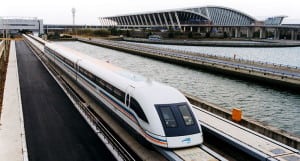Latest News
[Via Satellite 02-25-2014] Transportation industries are adding technology to enable connectivity on virtually every transit system. High-speed trains are no exception and represent another area of growth for satellite-based connectivity. Emerging Markets Communications (EMC) is making trains a primary focus for its business, arguing that satellite plays a more crucial role for these vehicles than for consumer aircraft.
“In general, the main market is both providing connectivity and providing management and control of the train,” Payam Herischi, president and COO of EMC told Via Satellite. “In airplanes, it is only providing connectivity. High-speed trains are as good as planes, especially in Europe and developing countries where they are using them more and more. The application that we have is not only providing Internet access for high-speed trains up to 350 kilometers per hour, but also management and control of the train.”
According to Payam, high-speed trains in particular are excellent candidates for satellite because, in addition to providing services such as Wi-Fi, satellite can augment the collection of data about the rails, stations and trains in a certain region. This provides greater purpose as, not unlike aircraft, it is often difficult to determine whether paid connectivity is something consumers will buy. Using satellite for accelerated management and control systems serves to further justify equipping trains with the technology.
“Previously, the train was going at 50 mph, and someone would look at the train passing the station and call in the next station,” said Herischi. “When you have a high-speed train, every second counts. So now you have to be able to provide the exact location of the train, the speed of the train, how it is moving, the status of each section of the railroad, and combine the information to provide a safe journey for the high-speed train.”
Other companies have also latched on to this market. Cisco, Gilat and others have invested in providing connected railway services. Part of the appeal stems from safety improvements. For starters, a train can be tracked throughout its route, without having to wait for periodic updates. Train headquarters can use remote monitoring equipment onboard to provide hazard alerts and collision prevention guidelines.
While many high-speed trains exist in Europe, Herischi said EMC is also focusing heavily on incorporating satellite connectivity into projects for new trains elsewhere.
“There are lots of new projects happening in developing countries by increasing the infrastructure,” he said. “Right now there are projects for high-speed trains in China, India, the Middle East, Africa — there is a huge growing industry providing high-speed trains.”
By working with ongoing projects, trains can be built with antennas, routers and other necessary equipment to enable satellite connectivity from the start. Governments like that satellite can make this particular method of transportation safer, making them more receptive to ideas about its implementation in public mass transit systems. While connectivity is not yet expected for every train, Herischi believes society is starting to perceive it as a must-have.
“I think it is going to move to that direction, especially in emerging markets,” said Herischi. “[Trains are becoming] a legitimate part of the infrastructure of many countries. Then, because of that you have to provide them with a solution that matches the other means of transportation. It is going to be part of the future.”
Get the latest Via Satellite news!
Subscribe Now